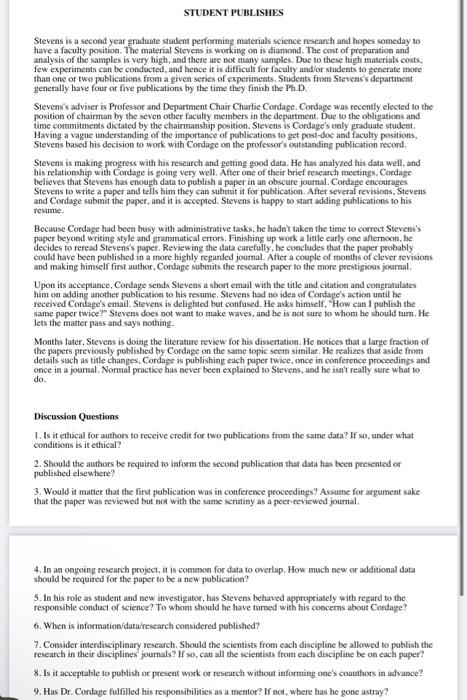Please answer all questions for a like and good rating :) THANKs!!!

Stevens is a secoed year graduate student performing materials science research and hopes someday 1o have a faculty position. The material Stevens is working on is diamond. The cost of preparation and analysis of the samples is very high, and there are not many samples. Due to these high materials costs, few experiments can be conducted, and hence it is difficult for faculty andior students to generate mose than one or two publications from a given series of experiments. Students from Stevens's department generally have four or five publications by the time they finish the Ph.D. Stevens's adviser is Professor and Department Chair Charlie Cordage. Cordage was recently elected to the position of chairman by the seven other faculiy members in the department. Doe to the obligations and time commitmens dictated by the chairmanship position, Stevens is Cordage's only graduate studeat. Having a vague understanding of the importance of publications to get posi-doe and faculty positions, Stevens based his decision to work with Cordage on the professor's outstanding publication record. Stevens is making progress with his research and getting good data. He has analyzed his data well, and his relationship with Cordage is going very well. After one of their brief research meetings. Cordage believes that Stevens has enoagh data to publish a paper in an obscure journal. Cordage encourages Stevens to write a paper and tells him they can submit it for publication. After several revisions, Stevens and Cordage submit the paper, and it is aceepted. Stevens is happy to start adding publications to his resume. Because Cordage had been busy with administrative tasks, he hadn't taken the time to correct Stevens's paper beyood writing style and grammatical ertors. Finishing up work a little early one afternoon, he decides to reread Stevens's paper. Reviewing the data carefully, he concludes that the paper probably coald have been published in a more highly regarded journal. After a cotple of months of clever revisions and making himself first author, Cordage subemits the research paper to the more prestigious journal. Upon its aceeptance, Cordage sends Stevens a short emal with the title and citation and congratalates him on adding another pablication to his resume. Stevens had no idea of Cordage's action until he received Cordage's email. Stevens is delighed but confused. He avks himself, "How can I poblish the same paper twice?" Stevens does not want to make waves, and he is not sure to whom he should turm. He lets the matter pass and says nothing. Months later, Stevens is doing the literature review for his dissertation. He notices that a large fraction of the papers previously publtished by Cordage on the same topic seem similar. He realizes that aside from details such as title changes, Cordage is publishing each paper twice, once in conference proceedings and once in a journal. Normal practice has never been explained to Stevens, and he isn't really sure what to do. Discussion Questions 1. Is it ethical for authors to receive credit for two publications from the same data? If so, under what conditions is it ethical? 2. Should the authors be required to inform the second publication that data has been presented or published elsewhere? 3. Would it matter that the first publication was in conference proceedings? Assume for argument sake that the paper was reviewed but not with the same serutiny as a peer-reviewed journal. 4. In an ongoing research project, it is common for data to overlap. How much new or additional data should be required for the paper to be a new publication? 5. In his role as student and new investigator, has Stevens behaved appropriately with regard to the responsible conduct of science? To whom should he have turned with his concerns about Cordage? 6. When is informationidara/research considered published? 7. Consider interdisciplinary research. Should the scientists from each discipline be allowed to publish the research in their disciplinex journals? If %, can all the scientists from each discipline be on each paper? 8. Is it acceptable to publish or present work or research without informing one's coauthors in advance? 9. Has Dr. Cordage fulfilled his responsibilities as a mentor? If not, where has he gone astray








